What Is a Cover Letter and Why Do You Need It? (+ Examples)
What is a cover letter for a job application? What is the purpose of writing a covering letter? A great CV isn't enough–see what a cover letter can do for you.
Our customers were hired by:
Progressing through your academic career requires a somewhat strategic approach. Academia is for the most part a fiercely competitive sphere. Whether you’re out there looking for research positions, teaching posts or both, you have many equally over-achieving and dedicated academics clamouring for the same jobs. Standing out and breaking through aren’t easy to do in this environment.
So the question arises of how to write a cover letter for an academic position that will put your application front and centre. This article is here to walk you through doing just that with academic cover letter examples better than nine out of ten out there. Just like the academic cover letter below.
Use the LiveCareer cover letter builder and your cover letter will write itself. Choose a professional template, answer a few easy questions and the creator will generate a professional cover letter for you with just one click.
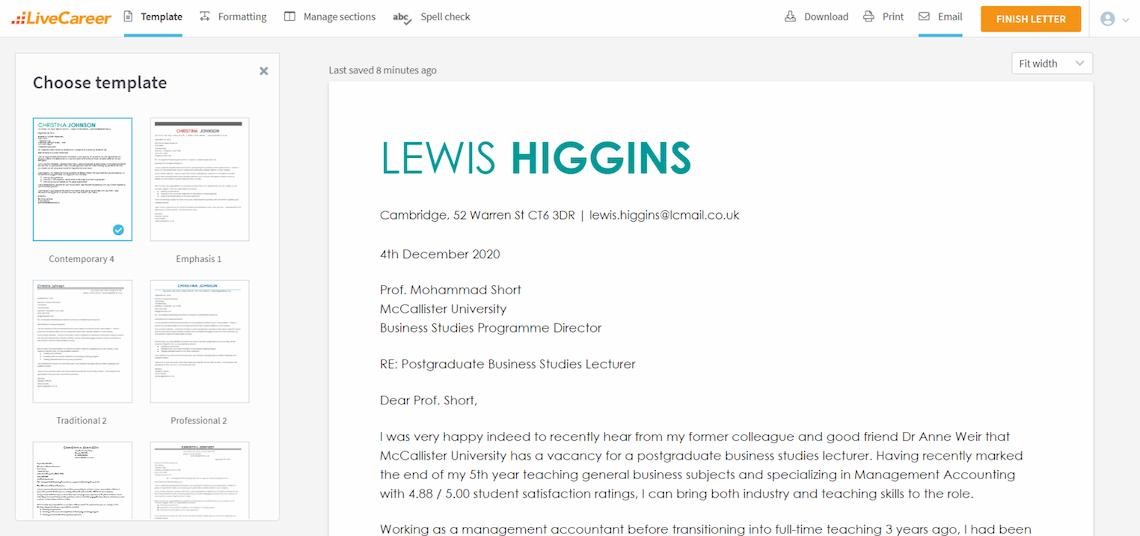
Want to learn more about writing cover letters for other purposes? Check these guides:
Couldn't find the one that interests you? See a full cover letter examples list.
Lewis Higgins, PhD
52 Warren St
Cambridge
CT6 3DR
072 3333 3333
lewis.higgins@lcmail.co.uk
4th December 2021
Prof. Mohammad Short
Business Studies Programme Director
McCallister University
99 Berkeley Rd
Cambridge
KA19 7AE
Dear Prof. Short,
I was very happy indeed to recently hear from my former colleague and good friend Dr Anne Weir that McCallister University has a vacancy for a postgraduate business studies lecturer. Having recently marked the end of my 5th year teaching general business subjects and specialising in Management Accounting with 4.88 / 5.00 student satisfaction ratings, I can bring both industry and teaching skills to the role.
Working as a management accountant before transitioning into full-time teaching 3 years ago, I had been responsible for accounts worth over 120 million pounds. Teaching subjects like Financial Statements for Managers, Management Accounting, Corporate Finance, Financial Risk Management, and Strategic Management among others, I worked with a total of over 400 MSc, MA, and MBA students. Both my assessment strategy and marking have passed AMBA, AACSB, and EFMD audits without any concerns or areas for improvement being raised while having my students achieve grades 5–10% higher than average. I was recently moved to learn that I had been voted ‘Best Lecturer’ for the third time running by the graduating class of Executive MBA students at the Manchester Trinity University Business School.
As you can perhaps gather from my achievements and accolades, I have a real passion for academia, teaching, and mentorship. The student-centred approach I have been developing is completely in line with the Dean’s recent editorial on the topic.
Thank you for taking the time to consider my application. Please do not hesitate to contact me at your convenience, I would love to discuss my candidature with you further.
Yours Sincerely,
Lewis Higgins
Now you know what is a cover letter and what should a cover letter include. Now, here’s how to write an academic cover letter:
The structural aspects of writing an academic cover letter (sometimes called a letter of application) are dictated by the standard UK business letter format. So start by aligning to the right your full name, postal address, email address, and phone number. Leave a line and add the date of writing, always in the form 23rd May 2021.
Leave another line and align to the left the recruiter’s academic title and full name, their job title, university or teaching/research institution, and campus address. When addressing a cover letter, you may also need to include the name of their faculty, school, and/or department and possibly even building name or number on larger campuses.
Lewis Higgins
52 Warren St
Cambridge
CT6 3DR
072 3333 3333
lewis.higgins@lcmail.co.uk
4th December 2021
Prof. Mohammad Short
Business Studies Programme Director
McCallister University
99 Berkeley Rd
Cambridge
KA19 7AE
You can adjust every cover letter created in the builder to meet the job requirements. Choose the name of your profession and the company to which you’re applying, and the LiveCareer cover letter builder will automatically adapt the content for you. Create a cover letter faster than you ever thought possible and apply for the job in record time.
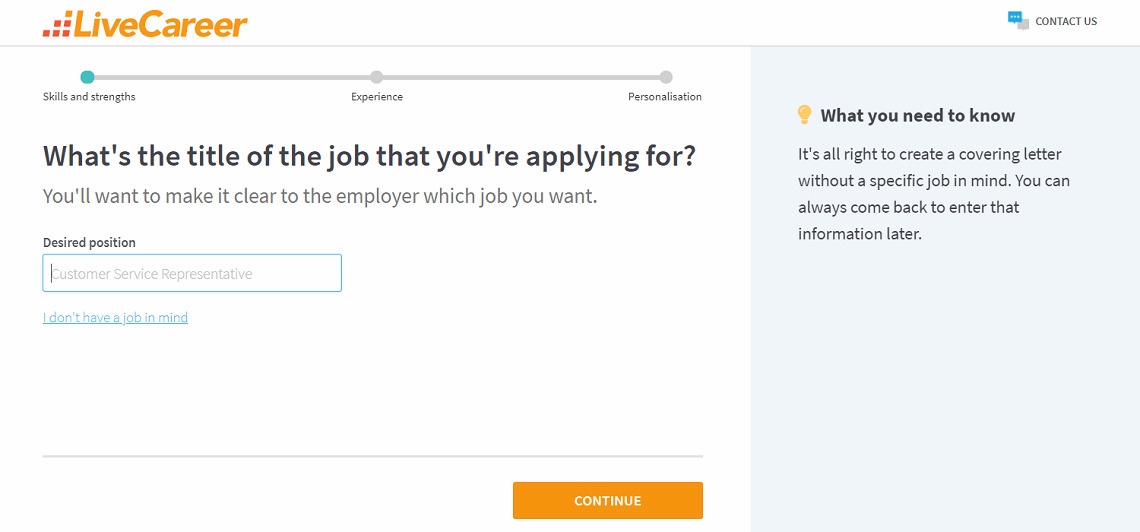
We all know how fussy academics can be about their titles. And when you take into account how much work, dedication, and sacrifice it can take to earn the title of Doctor or Professor, one can hardly blame them. Be sure you address them properly and start your cover letter with the right salutation.
Different educational institutions and even different faculties and departments within those institutions will have different cultures when it comes to how formal or familiar academics are with each other. Most, though, will be on a first-name basis with each other as the default. But you’re not there yet.
By far the safest salutation for you to use is ‘Dear + title + surname’. Use the abbreviations ‘Prof.’ and ‘Dr’ rather than the full words. Double and triple check that you’re using the right title. Don’t assume that staff pages are up-to-date. Rely on multiple recent sources, including Microsoft’s LinkedIn.
Use ‘Ms’ for women who don’t hold an academic title and ‘Mr’ for men. It may well be appropriate to use a salutation in the form ‘Dear + first name’ with non-academics and academics of a lower rank—use your better judgement and err on the side of formality when in doubt.
Non-academic titles tend to be gendered and require you take extra care to get your reader’s sex right. If you have any doubts as to a recruiter’s sex (some names aren’t much help here), then make sure you confirm and double-check their gender by searching online, especially on the institution’s website.
What happens if the job advert or notice doesn’t mention a particular recruiter by name? Ideally, you should find out for yourself. The quickest and most direct way to do this is simply to call and ask. It won’t take much detective work to find administrative or reception staff that are in the know.
In the extremely unlikely event that you truly can’t find out who is responsible for hiring in this case, then address your academic cover letter to the head of the programme, school or institute to which you’re applying. Absolutely avoid ‘To Whom It May Concern’ and anything similar— better mistaken than lazy.
Dear Prof. Short,
The opening paragraph of your academic cover letter is your opportunity to grab your reader’s attention, possibly your only opportunity if competition is fierce. Use your opening paragraph to communicate your enthusiasm for the role, give an idea of what you have to offer, and show that you’re a good fit.
Nothing shows enthusiasm like knowledge regarding the teaching or research institution to which you’re applying. For example, is the industry experience of their teaching staff one of their main selling points? If so, then highlight your industry experience and in doing so show that you’re in the know.
The best way to give an indication of what it is that you can bring to the institution is to show what benefits you’ve brought to previous employers. Do this by including one of your professional achievements. An achievement is typically the description of an action you took and the benefits it brought.
Actions like these are often taken in response to a problem or challenge, but they needn’t be. The most important thing is that you quantify everything you can, the benefits that your employer gained as a result of your actions first and foremost. Use something like a CAR statement to help with the structure.
Just starting your teaching and/or research career? Open your academic cover letter with your passion for the work of either teaching or research (or both) and the institution to which you’re applying. Include a relevant achievement from your casual teaching work or studies. Describe how you’d make a good fit with institution. It's not a general cover letter where you only discuss your skills, but rather an opportunity to show how your unique experiences, professional goals, and values align with the culture and vision of the institution.
If you have no experience at all, then substitute a belief statement for your professional achievement. Whether you have experience or not, be sure to mention it if you were referred to the role by someone within the institution.
Your application might be parsed by an ATS (Applicant Tracking System) before a person so much as takes a look at it. ATS algorithms can be gamed by massaging the keywords in your academic cover letter. So be sure to mention the institution and job title by name and mirror other keywords from the job advert.
Writing a cover letter for an academic job is an exercise in efficiency and the opening paragraph is far from being an exception here. As much as your opening paragraph will need to achieve, you should keep it at a brief 40–80 words.
I was very happy indeed to recently hear from my former colleague and good friend Dr Anne Weir that McCallister University has a vacancy for a postgraduate business studies lecturer. Having recently marked the end of my 5th year teaching general business subjects and specialising in Management Accounting with 4.88 / 5.00 student satisfaction ratings, I can bring both industry and teaching skills to the role.
You don’t have to create any content yourself. The LiveCareer cover letter generator will automatically suggest the best content for your cover letter with ready-made examples and expert tips.
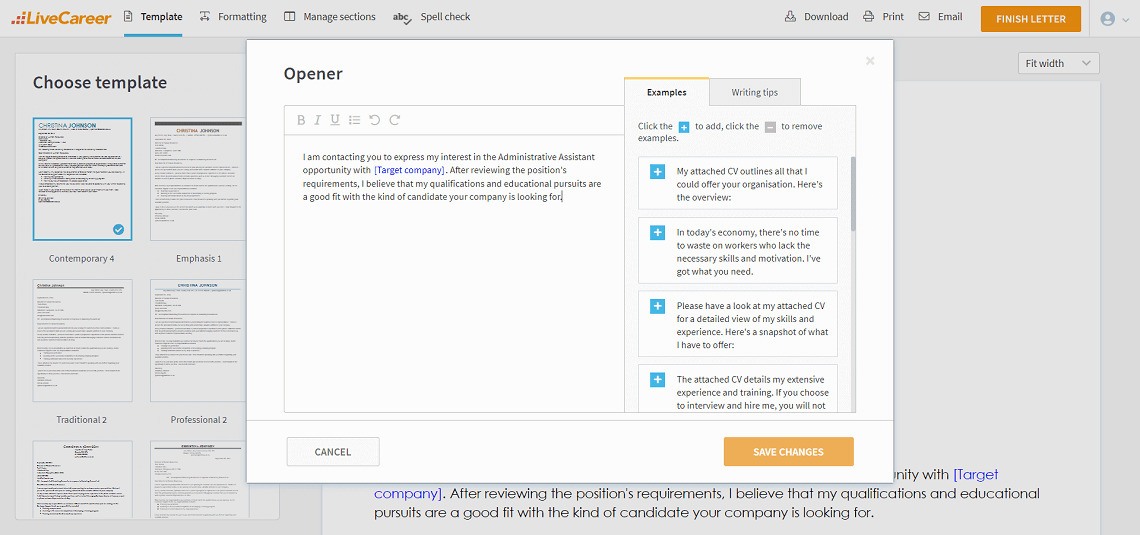
Even though a significant proportion of being an academic is difficult to pin down in concrete terms, your performance as either or both a member of the teaching and research staff is surprisingly well-defined by various metrics. From teaching evaluations to impact factors, your performance is measurable.
Use the main body paragraphs of your academic cover letter to outline 2–4 achievements, just like the one you included in your opening paragraph. Add just enough prose to string your achievements into a coherent whole, if not a narrative or de facto argument indicating why you’re the right one for the job.
Break this part of your cover letter down into two paragraphs if you feel one paragraph will constitute too big a block of text. Whether you go with one or two paragraphs, consider using bullet points to enhance readability further. Quantify everything possible, even if you need to estimate metrics to do so.
As with every part of your academic cover letter, the more efficient your use of words, the better. Your reader will be in a hurry——make your cover letter a breath of fresh air rather than a convoluted bore. Keep it short at 120–200 words.
Working as a management accountant before transitioning into full-time teaching 3 years ago, I had been responsible for accounts worth over 120 million pounds. Teaching subjects like Financial Statements for Managers, Management Accounting, Corporate Finance, Financial Risk Management, and Strategic Management among others, I worked with a total of over 400 MSc, MA, and MBA students. Both my assessment strategy and marking have passed AMBA, AACSB, and EFMD audits without any concerns or areas for improvement being raised while having my students achieve grades 5–10% higher than average. I was recently moved to learn that I had been voted ‘Best Lecturer’ for the third time running by the graduating class of Executive MBA students at the Manchester Trinity University Business School.
Writing is an unavoidable and undeniably huge part of being an academic of any stripe. Flex those skills by neatly summarising the main body paragraphs of your academic cover letter. Tie up any loose ends, but don’t try to fix what isn’t broken or repeat yourself unnecessarily. Keep it brief: 40–60 words.
Thank the recruiter for the time and effort they’re putting into considering your application. This isn’t just a matter of having good manners, there’s an element of calculation to it as well. End your cover letter on a bold (but suitably respectful) call to action (CTA). Show your eagerness and suggest a follow-up discussion.
As you can perhaps gather from my achievements and accolades, I have a real passion for academia, teaching, and mentorship. The student-centred approach I have been developing is completely in line with the Dean’s recent editorial on the topic.
Thank you for taking the time to consider my application. Please do not hesitate to contact me at your convenience, I would love to discuss my candidature with you further.
Few aspects of the application process for jobs in academia are going to be as easy as choosing the right sign-off for your academic cover letter. Use ‘Yours Sincerely’ if you addressed the cover letter to somebody by name and use ‘Yours Faithfully’ if you didn’t.
Leave two or three lines and then type out your full name. Sign above your name if you’re going to be printing out your application and submitting it in hardcopy. Leave the extra space even if you’re sending everything in electronically. You could paste in a high-quality scan of your signature, but it’s not necessary.
Yours Sincerely,
Lewis Higgins
As an academic, you’re all too familiar with the need to properly present your written work, from undergraduate assignments to conference-paper abstracts and grant proposals. Those skills as well as more general attributes like conscientiousness are on display in your academic CV and cover letter.
Sticking to word limits is also nothing new to you. How long should an academic cover letter be? Keep your cover letter short, with a total of about 250–400 words. Space your academic cover letter out such that it nicely fills a single A4 page, never more. Leave margins at the default 2.5 cm. Leave font size at 11–12 points.
When formatting your cover letter, choose a professional and understated font like Noto, Garamond, Liberation, Arial, or even Calibri. Make subtle use of font, line-spacing, and most importantly plenty of white space to maximise the readability of your cover letter. For a neat cover letter layout, use bullet points to break up long passages of text where appropriate.
Remember that a cover letter for an academic position is only one part of the job application. Your academic CV and cover letter make up the application together—the overall look and layout of your documents should reflect this fact. This means matching the font, layout, and any colours you use. Use a simple template, fancy templates may equal worse readability.
Be sure to save or export your perfect cover letter in PDF, unless of course you’ve been asked to use another file format. Working in academia, you’ve probably seen more than one submission or presentation ruined by a less stable format, like *.docx.
Lastly, be sure to proofread your cover letter, or ask someone else to review it for you. You can also use an AI cover letter generator for suggestions and improvements to help streamline the writing process, but avoid relying on it entirely. Best of luck with your academic cover letter!
A cover letter alone simply won’t be enough—you need an impactful CV, too. Create your CV in minutes. Just follow our wizard and fill in every CV section with ready-made content. Get started by choosing a professional CV template.
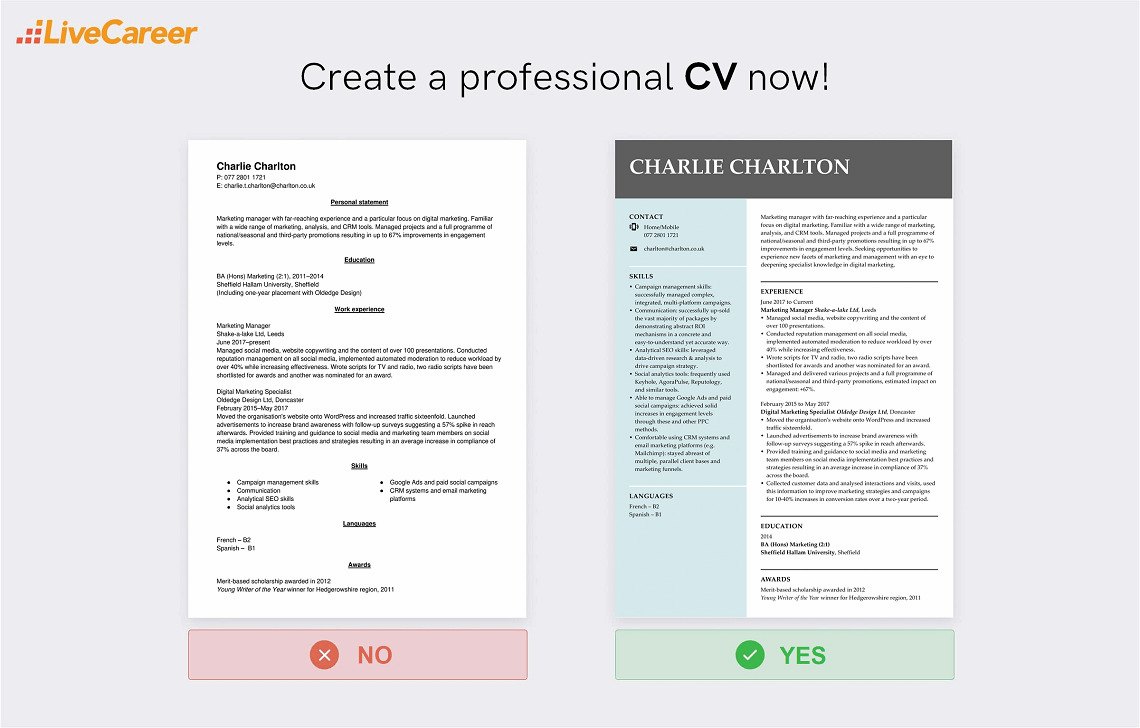
Was this article about an academic cover letter helpful to you? As different as academic jobs can be from other lines of work, the basics of job-hunting are the same. Is there anything I’ve mentioned here that you’d like me to elaborate upon? Please leave any questions, comments or experiences you have to share down below.
Our editorial team has reviewed this article for compliance with Livecareer’s editorial guidelines. It’s to ensure that our expert advice and recommendations are consistent across all our career guides and align with current CV and cover letter writing standards and trends. We’re trusted by over 10 million job seekers, supporting them on their way to finding their dream job. Each article is preceded by research and scrutiny to ensure our content responds to current market trends and demand.
About the author
Since 2013, the LiveCareer UK team has shared the best advice to help you advance your career. Experts from our UK editorial team have written more than one hundred guides on how to write the perfect CV or cover letter.
Rate this article:
Academic cover letter
Average:
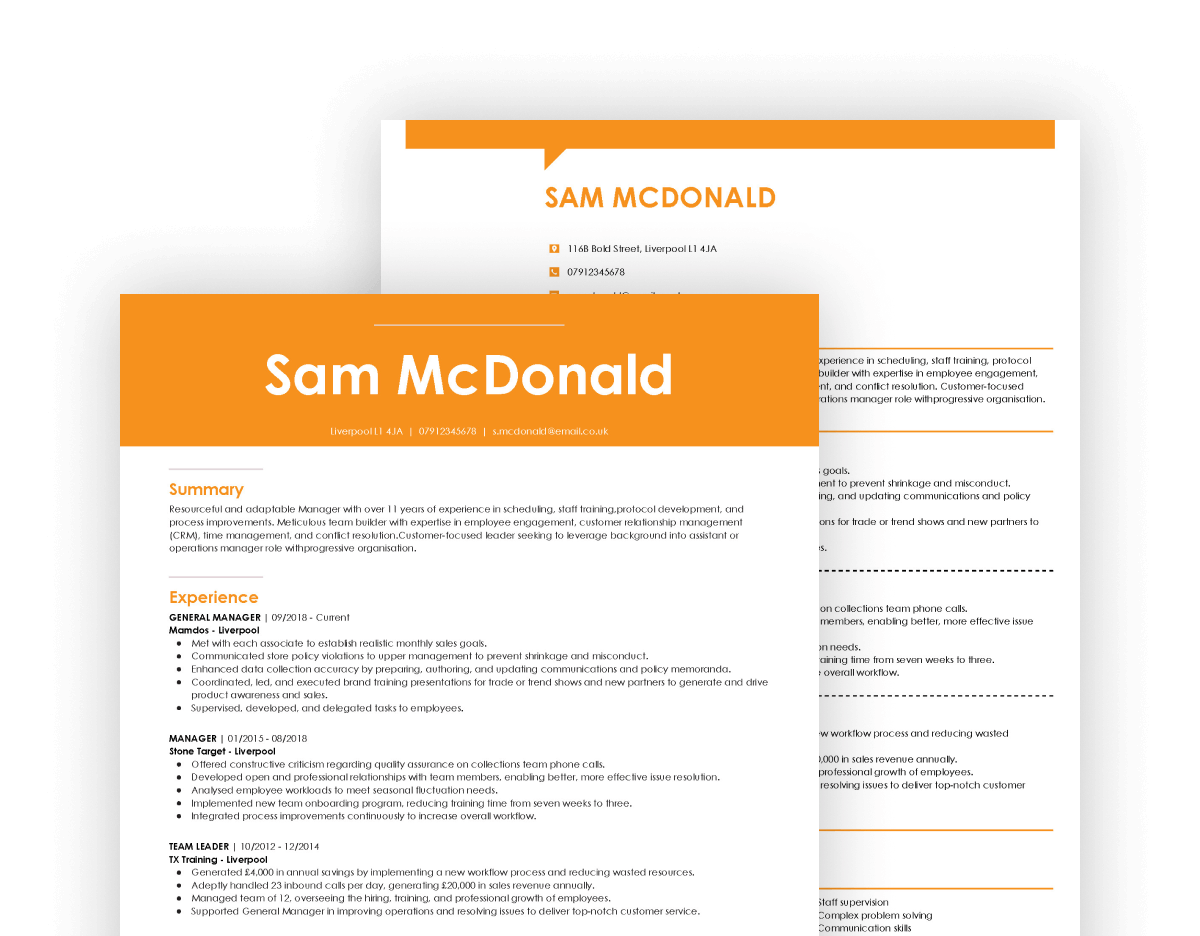
What is a cover letter for a job application? What is the purpose of writing a covering letter? A great CV isn't enough–see what a cover letter can do for you.
Write a motivational letter and strengthen your application. Express your enthusiasm and hope for the opportunity with a perfect motivation letter for a job.
How to write a letter of application that'll make recruiters take notice? See letter of application example to guide you through the whole process.
Our customers were hired by: